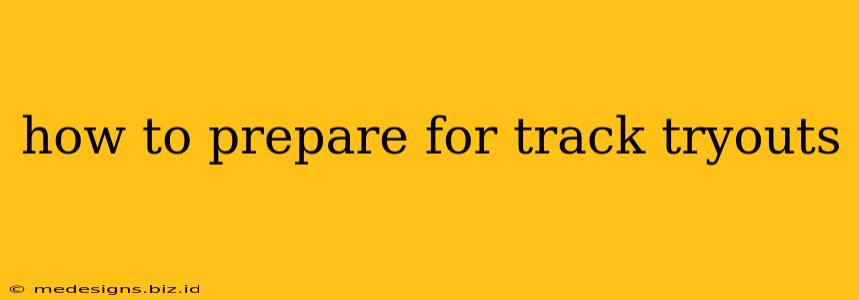So, you're ready to try out for the track team? That's fantastic! Track and field is a challenging but incredibly rewarding sport. Proper preparation is key to showcasing your abilities and making the team. This guide will walk you through everything you need to know to prepare for your track tryouts.
Phase 1: Pre-Tryout Conditioning (4-8 Weeks Before)
This phase focuses on building a strong foundation of fitness. Don't wait until the week before tryouts to start training!
1. Cardiovascular Endurance:
- Running: The cornerstone of track. Begin with a base level of running, gradually increasing distance and intensity. Include interval training (alternating high-intensity bursts with rest periods) to improve speed and stamina. Aim for at least 3-4 runs per week.
- Cross-Training: Incorporate activities like swimming, cycling, or elliptical training to build cardiovascular fitness without stressing your running muscles too much. This helps prevent injury and improves overall endurance.
2. Strength Training:
- Leg Strength: Focus on exercises like squats, lunges, deadlifts, and calf raises to build the strength necessary for sprinting, jumping, and distance running.
- Core Strength: A strong core is essential for balance, power, and injury prevention. Incorporate planks, crunches, and Russian twists into your routine.
- Upper Body Strength: While not as crucial as lower body strength for most track events, upper body strength helps with overall power and stability.
3. Flexibility and Mobility:
- Stretching: Regularly stretch your muscles to improve flexibility, reduce the risk of injury, and enhance performance. Include dynamic stretches (movements like leg swings and arm circles) before workouts and static stretches (holding a stretch for a period) after workouts.
- Foam Rolling: Use a foam roller to release muscle tension and improve mobility. This is especially important for runners who often experience tight muscles in their legs and hips.
Phase 2: Specificity Training (2-4 Weeks Before)
Now it's time to focus on the specific events you plan to try out for.
1. Sprints (100m, 200m, 400m):
- High-Intensity Intervals: Focus on short bursts of speed followed by adequate rest periods.
- Start Technique: Practice your starts from the blocks. Proper starting technique is crucial for sprinting success.
- Speed Drills: Incorporate drills like bounding, skipping, and high knees to improve speed and power.
2. Middle Distance (800m, 1500m):
- Tempo Runs: Sustained runs at a comfortably hard pace to build aerobic capacity and lactate threshold.
- Interval Training: Longer intervals with shorter rest periods than sprint intervals.
- Endurance Runs: Longer, slower runs to build base endurance.
3. Distance (3000m, 5000m):
- Long Runs: Gradually increase the distance of your long runs over several weeks.
- Easy Runs: Low-intensity runs to build aerobic base.
- Hill Repeats: Running uphill at a hard pace to build strength and stamina.
4. Field Events (Jumps, Throws):
- Technique Focused: Practice the specific techniques of your chosen field event (e.g., high jump, long jump, shot put, discus).
- Strength Training: Emphasize strength training exercises specific to your event.
Phase 3: The Week Before Tryouts
This week is about tapering and fine-tuning.
- Reduce Training Volume: Decrease your training volume to allow your body to recover and store energy.
- Maintain Intensity: While reducing volume, maintain the intensity of your workouts to stay sharp.
- Rest and Recover: Get plenty of sleep and prioritize rest to ensure you're well-rested and ready to perform your best.
- Nutrition: Eat a healthy, balanced diet to fuel your body.
Tryout Day:
- Warm-up Properly: Dynamic stretching and light cardio to prepare your muscles for activity.
- Stay Focused: Don't get discouraged if you don't perform as well as you'd hoped in every event.
- Give Your Best: Show the coaches your dedication and potential.
- Cool-Down: After your tryout, cool down properly with static stretching to prevent muscle soreness.
Remember to listen to your body, and don't hesitate to consult a coach or athletic trainer if you have any questions or concerns. Good luck with your tryouts!
